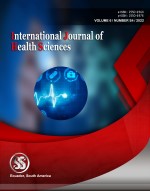Standard levels of physical fitness components as one of the admission indicators for students of sports excellence
The University of Jordan
Keywords:
standard levels, physical fitness, tests, athletic excellence, the University of JordanAbstract
Study provide standard levels of physical fitness tests for students applying for study seats at the University of Jordan on the list of sports excellence for the period between (2017-2020). By descriptive on a sample of (283) male and (169) female students to fulfill the study's goal. The study included the following tests: a 1600m running test to assess respiratory cyclic endurance, a long jump test from stability to assess explosive force of the leg muscles, a running rebound test (4x10m) to assess agility, and a medical ball throw test with a weight of (5) kg for male students and (3) kg for female students to assess strength. The explosiveness of the arm muscles. The study's findings revealed the most recent standard levels of the tests employed in the study, allowing them to keep up with societal trends. It is well recognized that there is a requirement to make some changes to the test standards every three years. These parameters, according to the researchers, should be employed in physical fitness assessments that qualify students for skill testing at the University of Jordan.
Downloads
References
Abdel-Haq, Emad Saleh (2005) Building Anthropometric Characteristics for Fourth and Fifth Grade Students (10-9) years in Nablus Governorate. . An-Najah Journal for the Humanities, 19(2), 396-371.
Al-Janabi, Salman (2016). Grades and Standard Levels, Lecture No. 50, University of Kufa, College of Physical Education and Sports Sciences, Iraq, p. 2.
Al-Khasawneh, Aman and Shoka, Nart and Ghasab, Ismail and Abdel Hafez, Abdel Basset (2009). Determining standard levels of physical fitness among students of the Faculty of Physical Education at Yarmouk University, Journal of Educational Sciences Studies, 36, 251-237.
Allawi, Muhammad and Radwan, Muhammad (2000). Measurement in physical education and sports psychology. Arab Thought House, Cairo.
Ariwibowo, M. F., Wahab, Z., Isnanta, R., & Isnurhadi, I. (2020). Physical evidence promotion on consumer decisions in using bowling sport services. International Journal of Social Sciences and Humanities, 4(3), 22–28. https://doi.org/10.29332/ijssh.v4n3.445
Athab, Abbas (2007). Building and legalizing a physical test battery for admission to military colleges. Journal of Physical Education Sciences, University of Babylon, special issue of the 16th Conference of the Faculties of Physical Education in Iraq.
Ebbeling, D. Pawlak, B. & Ludwig, D. (2002). “Childhood obesity: public-health crisis, common sense cure,” Te Lancet, 360(9331): 473–482.
Emrich, E. Pitsch, W. Guellich, A. Klein, M. Froelich, M. Flatau, J. Sandig, D. & Anthes, E. (2008). Spitzenfoerderung in Deutschland. Best and aufnahmen und prespektiven. Leistungs sport, 38 (1), 1-20.
English References
Greenberg H. Raymond SU. &Leeder SR.(2011). The prevention of global chronic disease: Academic public health’s new frontier. Am J Pub Health. 101(8):1386–90, http://dx.doi. org/10.2105/AJPH.2011.300147.
Leung FP. Yung LM. Laher I. Yao X. Chen ZY. & Huang Y. (2008). Exercise, vascular wall and cardiovascular diseases: An update (Part 1). Sports Med. 38(12):1009–24, http://dx.doi. org/10.2165/00007256-200838120-00005.
Mathews, ok (2003). Measurement in Physical Education. 5th Ed, Saumer Company.
Mesa, J. Ruiz, R. Ortega, F. Warnberg,J. González- Lamuno, D. & Moreno, L. (2006), Aerobic physical fitness in relation to blood lipids and fasting glycaemia in adolescents: Influence of weight status. Nutr Metab Cardiovasc Dis. 16(4) ,285–93
Shuber, Mahmoud Ibrahim and Nizar, Al-Talib and Sami Abdel-Fattah (2005). Setting standard levels for physical ability tests to accept female students in the Department of Physical Education, Journal of Physical Education, University of Bahrain, 14(1), 24-1.
Suryasa, I. W., Rodríguez-Gámez, M., & Koldoris, T. (2022). Post-pandemic health and its sustainability: Educational situation. International Journal of Health Sciences, 6(1), i-v. https://doi.org/10.53730/ijhs.v6n1.5949
Vìtalina, N., Valentyna, V., Olexandr, S., Iryna, R., & Roman, O. (2022). The influence of digital creative technologies on the development of education and medicine. International Journal of Health Sciences, 6(2), 699–708. https://doi.org/10.53730/ijhs.v6n2.7669
Published
How to Cite
Issue
Section
Copyright (c) 2022 International journal of health sciences

This work is licensed under a Creative Commons Attribution-NonCommercial-NoDerivatives 4.0 International License.
Articles published in the International Journal of Health Sciences (IJHS) are available under Creative Commons Attribution Non-Commercial No Derivatives Licence (CC BY-NC-ND 4.0). Authors retain copyright in their work and grant IJHS right of first publication under CC BY-NC-ND 4.0. Users have the right to read, download, copy, distribute, print, search, or link to the full texts of articles in this journal, and to use them for any other lawful purpose.
Articles published in IJHS can be copied, communicated and shared in their published form for non-commercial purposes provided full attribution is given to the author and the journal. Authors are able to enter into separate, additional contractual arrangements for the non-exclusive distribution of the journal's published version of the work (e.g., post it to an institutional repository or publish it in a book), with an acknowledgment of its initial publication in this journal.
This copyright notice applies to articles published in IJHS volumes 4 onwards. Please read about the copyright notices for previous volumes under Journal History.
















